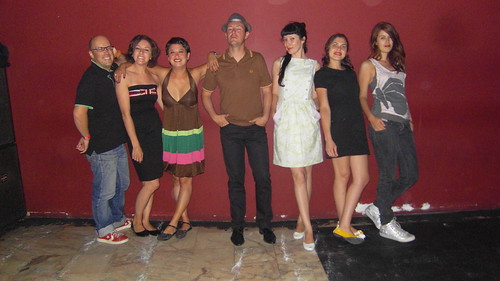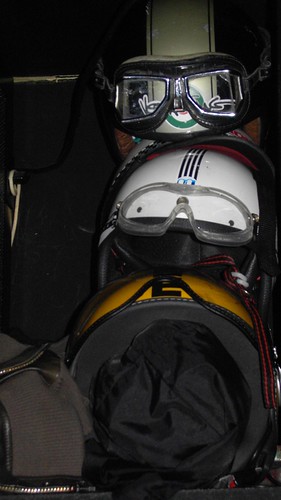Wednesday 29 July 2009
Faulty headlight socket
"I have checked out your headlight situation, and it appears that your headlight socket is faulty. It is grounding out somehow. I'm not really sure how it is possible, but it is doing it. The light works when I just put the wires to the bulb, but everything grounds when I put the bulb in the socket. I guess you need a new socket. I'm hoping to tear into the clutch this weekend."
I have emailed ScooterWorks to see if they will honor a warranty on that part. Waiting to hear back from them.
Soda blasting and powder coating in East Bay San Francisco
Hello Leons Family,
I am restoring a 1962 Italian Lambretta motorscooter. It is all metal. There are three things I'd like to you if (1) you do, (2) what the ball park estimate is, and (3) what type of turn around can I expect?
---------- Projects ----------
1) I need to have two engine (3/4s the size of lawn mower engine) cases soda blaster. I have a friend who may also wish to do one to two of his engines at the same time if we can get a "batch" rate on the job.
2) My scooter will require some very light body work straightening out two to four panels of the body.
3) I would like to have my entire scooter body prepped and painted in two colors. It would look like this:
http://www.smellofdeath.com/lloydy/images/Jays_tv175_1.jpg
This may serve as a point of reference:
http://lambrettarestoration.blogspot.com/2007/10/vision-for-when-all-is-said-and-done.html
The majority of the parts are quite small.
In coral red (Lechler system colors #8065)
fork, frame, leg-shield, handle bar and headset, floorboard tunnel, wheel hubs, front disc brake backing plate, wheel rims, spare wheel holder, glove box lid, tail-light body, fuel tap hatch, stand, stand mudguard, right-hand rear running board L-bracket air intake (beneath saddle), side-panels, front cowling, horn grille, and front mudguard (fiberglass).
In new white (Lechler system colors #8059):
fuel tank, rear mudguard, cylinder head, air intake manifold (2 pieces), glove box, air box, filter carrier, fuel tank support strap, and battery support strap.
---------- ---------- ---------- ----------
I recognize I provided an abundance of information, but I figured too much is better than two little). I suspect it is possible that you have also done some work on vintage Lambretta scooters as well. Guillermo of Lambretta Works says you guys do great work.
Note: I will post the response. I am very close to being ready to soda blast my engines.
Live long and prosper

Este verão tem trazido algumas boas noticias para o scooterista, da capital e não só. Do estacionamento em Lisboa à aprovação da legislação das 125, motivos não parecem faltar para que, finalmente, algumas pessoas se entusiasmem a dar o salto para as duas rodas. O aumento do numero de utilizadores trará inegáveis benefícios (inclusive de segurança) para todos, ao criar mais visibilidade para esta nossa minoria, tantas vezes desprezada pelo legislador e pelos outros utentes da via.
As marcas já redobraram esforços na publicidade, sobretudo aos seus modelos de 125 centímetros cúbicos de cilindrada, esperando conseguir em Portugal o espectacular aumento de vendas que legislação similar produziu noutros países europeus. Isto numa altura em que a lei ainda nem foi promulgada. Mas não há nada de errado com isso, é importante que a mensagem passe. Temo no entanto pelo futuro destes novos condutores. Se tirando a carta uma pessoa sente que é literalmente atirada aos lobos, sem ter formação prática nenhuma os riscos serão ainda maiores.
O meu actual percurso diário casa-trabalho e trabalho-casa não soma mais de uma vintena de quilómetros, a maior parte deles por zonas de boas estradas, bem sinalizadas e com limites de velocidade entre os 70 e os 40 km/h. Mesmo assim, a quantidade de asneiras que observo diariamente é tremenda, com tendência para aumentar com o maior volume de tráfego que a zona da linha tem de suportar nesta época do ano. Excesso de velocidade, manobras perigosas, desrespeito pela sinalização vertical e luminosa, circulação em sentido proibido, o A-B-C do automobilista português está demasiado presente no meu dia-a-dia. Naturalmente, as consequências também: não houve dia desta semana em que eu não presenciasse pelo menos um acidente, ou as suas sequelas.
No meio dos vidros partidos, da chapa amolgada, dos animais atropelados e deixados à sua sorte, recordo sobretudo um acidente há dois dias, envolvendo uma mota. No caos, na azafama dos condutores a tentarem contornar mais este empecilho que os fazia perder uns segundos na sua corrida até ao semáforo seguinte, apercebi-me de que se tratava de uma pequena GN 250 ou a semelhante CM 125. Uma mota de instrução. Não muito longe do motociclo deitado por terra, estavam imobilizados um carro de uma escola de condução, e um outro veiculo. O instrutor, fora da viatura, fazia nervoso uso do telemóvel, enquanto não muito longe, a sua aluna, sentada no asfalto, ainda com o capacete colocado, era confortada por alguém.
Conseguem imaginar o desanimo desta jovem, deitada ao chão na própria aula de condução? Não faço ideia das lesões, mas ela parecia bastante queixosa. Estatisticamente a imensa maioria destas colisões tem consequências físicas. Eu sei disso. Chegará ela alguma vez a concluir as aulas? Voltará sequer a subir a um veículo de duas rodas?
Tenham cuidado aí fora.
Tuesday 28 July 2009
Lambretta tools by Dien Nguyen
Anyhow, I showed him pictures and measurements of a clutch compressor I borrowed from Dano of FLCSC in Oakland and this is what he made me (note that Dano's is in back of mine):
 I ended up with a professional quality clutch compressor for free made from scraps at my father-in-law's work. I am pretty damn happy.
I ended up with a professional quality clutch compressor for free made from scraps at my father-in-law's work. I am pretty damn happy.  I wasn't overly worried about polishing mine, but I did grind/sand down the tip of the bolt so as it would not hurt the scoot itself. An alternative design can be found here. It would look something like this.
I wasn't overly worried about polishing mine, but I did grind/sand down the tip of the bolt so as it would not hurt the scoot itself. An alternative design can be found here. It would look something like this.Another tool he made for me was the con-rod tool. Mr. Nguyen followed Jim M.'s design on this one. I can grind the inside smooth no problem, but to be honest it may not be necessary. Crude looking tools that function properly do not bother me at all as long as they do not hurt the scoot. A crude looking restoration is what would bother me.

Thanx Bo (dad in Vietnamese). As usual I owe you one!
Dance Craze em Almada Velha
Precisa-se para Videoclip dos Ratazanas, 6 Scooterboys c/ Vespas ou Lambrettas!!

Precisa-se para Videoclip dos Ratazanas, 6 Scooterboys c/ Vespas ou Lambrettas!!
Os Ratazanas vão gravar o seu 1º videoclip do tema "Grandma DJ" e procuram 6 Scooterboys e as suas respectivas maquinas para participar no mesmo.
As filmagens vão decorrer neste próximo sábado dia 1, a partir das 12h em Oeiras, numa vivenda junto ao Centro Comercial Palmeiras. Haverá comida e bebida e música dos Ratazanas!!
Para confirmar a vossa presença/mais detalhes entrem em contacto com a produção:
Joana Mendes
214073515 - 969171721
Para ouvirem a música dos Ratazanas...
www.myspace.com/theratazanas
Graver, abre loja na Baixa

Já se encontra aberta ao público a Graver Shop. Nesta loja situada bem no centro de Lisboa podes encontrar muita roupa e acessórios de marcas como: Dr. Martens, Fred Perry, Ben Sherman, Merc, Lambretta, Warriors, entre outras. Parece que brevemente também irão ter à venda material da Lonsdale. A morada é: Rua da Madalena, nº 80 - Loja D/F - 1100-322 Lisboa. O horário de funcionamento é o seguinte: Das 10h00 às 19h00. Período de almoço das 14h00 às 15h00. O site online e o mail são: www.graver.pt - info@graver.pt
Monday 27 July 2009
Adidas Vespa
Durante o fim-de-semana passado, alguns membros do gangue andaram por vários locais de Lisboa a espalhar a mensagem sobre os novos ténis Adidas Vespa. Na tarde de sábado estivemos nas Docas, fomos a Belém e andamos pelo Chiado, Camões e Bairro Alto... A nova linha de calçado Adidas Vespa, está a venda nas conhecidas lojas The Athlete's Foot. Ao adquirires um modelo Adidas Vespa, sim, nós já andamos com os PX's! Confirma-se, cada modelo ténis Adidas tem os mesmos nomes dos modelos Vespa; exemplo existe Sprint, PX...tiras uma foto engraçada contigo ou teus amigos e habilitas-te a uma viagem a Roma.
Vejam com o video do primeiro dia, houve fotos de malta com as nossas Vespas e muito charme Vespista... No domingo, estivemos em Cascais, marina, Santini, São João do Estoril e Carcavelos eis o segundo video, onde destacamos a fotogenia do Massimo, estava totalmente empenhado em se mostrar na objectiva que ia subindo o passeio (ao minuto 1.51...) este video foi filmado com a pocket camera Vado da Creative. Espero que se divirtam a vê-lo, tal como nos divertimos neste fim-de-semana.
Reference: Lambretta Tools
 Flywheel holding tool with one tooth. See Jim M.'s plans on this blog to make this tool as well. Note: the electric flywheels benefit from a longer tooth than this tool has.
Flywheel holding tool with one tooth. See Jim M.'s plans on this blog to make this tool as well. Note: the electric flywheels benefit from a longer tooth than this tool has. Rear hub puller. I am not certain that this puller has to be circular. This in one tool my father-in-law is working on currently for me. He will use steel and a tap/dye set to run fine threads through it. I also wonder if an electrical conduit for $5 from Home Depot could be easily adapted for this tool.
Rear hub puller. I am not certain that this puller has to be circular. This in one tool my father-in-law is working on currently for me. He will use steel and a tap/dye set to run fine threads through it. I also wonder if an electrical conduit for $5 from Home Depot could be easily adapted for this tool. I will also be able to fab this tool to remove the gudgeon pin from the piston.
I will also be able to fab this tool to remove the gudgeon pin from the piston.I will post pictures of the tools I had made in a later post.
Sunday 26 July 2009
Lambretta tool: Jeremy Sutton's silent block extractor/installer
My very basic silent block tool design. Here's what I used:
1) 1/2 x 8 inch bolt with welded nut on one side (recommend you do not weld it for ease of use).
2) A variety of washer sizes with quite a few small ones so I can stack them up when extracting the sb.
3) 2x3 inch pipe.
4) 2 and 1/2 inch circles cut in steel with with 1/2 inch hole in middle for bolt.
5) I used an angle grinder to smooth all surfaces.
Note: one modification I will make on my next trip to Portland (where I make my tools with my father-in-law, who has 30 plus years welding experience and more) will be to cut a new pipe a bit longer with a carved arch in it to fit the engine case perfectly and ensure the sb is pulled out perfectly straight.

My design for the silent block tool was stolen from an old LCUSA post and then somewhat adapted. You can make it easily with one trip to Home Depot as well or from scraps from a construction yard.
Lambretta tool: Kieran Walsh's & Stewart Nicol's silent block extractor/installer
 Above is the plan designed by Kieran Walsh& Stewart Nicol.
Above is the plan designed by Kieran Walsh& Stewart Nicol. The extractor is on the left side and the installer is on the right.
The extractor is on the left side and the installer is on the right.
 Here is the tricky cut outs to fit the engine case.
Here is the tricky cut outs to fit the engine case. 2 inch section.
2 inch section. 2 and 1/2 inch section.
2 and 1/2 inch section.Thursday 23 July 2009
S - U - R - R - E - A - L
Tuesday 21 July 2009
Keep the Faith!! As fotos da festa de Julho e noticias...













Mais uma noite daquelas, havia os The Killers no Restelo, as festas de Negrais que nos roubaram muitos amigos, mas mesmo assim o Europa encheu para a última noite de Verão. Promessa de regressar em Setembro, em data a anunciar aqui e no nosso facebook. Muitas caras amigas e novos aderentes, não quiseram deixar a noite acabar sem aquele feeeling festivo e alegre que caracteriza as nossas festas.
Em Setembro, além de uma noite Vespa Gang em Lisboa, vamos marcar presença no Iº Rally Ibérico de Scooters a decorrer em Caceres nos dias 17/18 Setembro, depois em tour até ao 3º ScooterPT Camping que vai ter lugar no local de sempre, o Camping Louriçal (entre Leiria e Figueira da Foz) nos dias 26/27 Setembro.
Mas antes e já neste fim-de-semana vamos espalhar a palavra numa acção conjunta com a Adidas Vespa...fiquem atentos! ;)
Monday 20 July 2009
Lambretta tool set part #2
The original BBS thread here:
artclone
Member since Apr-29-03
20 posts Mar-12-04, 09:37 PM (EDT)
"RE: Lambretta Engine Silent blocks removal"
In response to message #1
I followed instructions I found on this list - do a search. The instructions below are good, but the original was better.
It is easy to make a good puller/press yourself. Bring your silent block to the local hardware store. I went to ACE. You can make a puller with standard, non-metric, parts - pipe and nuts, bolt, and washers.
There is no way to break a case using this puller. Broken cases are caused when people use hammers to do this job.
Go to the plumbing section and get a standard iron pipe wide enough to just fit over the silentblock (sb from now on) and a touch longer than the length of the sb. This is needed to pull the old silent block out.
Get 2 giant washers as wide as the outside of the pipe. These will be used for pulling and pressing.
Get 4 smaller washers as wide as the sb small end (the right ones will be a touch narrower) These will pull out the sb from the inside.
Get a bolt a bit longer than the pipe and 1/2 the silentblock and 6 washers and nut together, but not too long. It should be just narrower than the hole in the silent block.
Get a nut and a spare to fit the bolt
---------------------
this works perfectly every time. you pull the old sb out using all parts - slip the pipe over the old sb. Insert bolt and 2 small washers from inside of engine mount; nut, small and large washers on the outside. Tighten nut and bolt until sb comes out. Use heat if you really think you need to, but if the mount isn't coming out, the problem is probably with the way you are using the puller.
Check new sb and engine mount surfaces for obstructions and sand off if needed. Lightly grease the outside of the new silent block and the inside of the engine mount, gently tap sb in the case just a bit with a rubber mallet. Putting a new sb requires the bolt, nut, and 2 small and 1 large washer on both the inside and outside. Put bolt through outside this time. Press new sb in by tightening nut and bolt.
Here's a good picture of the real deal i found as well.
Electrics Update
"I'm actually suspecting the brake backing plate (as the scraping sound problem). It is possible it is powdercoat (being thick and scraping), but more likely it is because it is slightly bent somehow. Once I get the rear hub off, I can inspect the back plate for any rubbing.
In the mean time, I spent several hours on the electrics yesterday. I've traced the power to the tail light and switch, and to the wires to the headlight. The light should work, but it doesn't. After a bunch of checking, it is starting to look like your (brand new) headlight assembly is faulty. I'm going to have to do some more checking to confirm this, but I ran out of time.
Once I get the lights sorted, I'll start on the scraping noise and the clutch."-- Paul
So I was correct that I wired the tail light incorrectly. Not sure what I was thinking back then, because when I studied the diagram earlier this month I knew immediately that my wiring job was wrong. I did not know that the switch being cracked would result in grounding. So I learned something new. I am not sure if ScooterWorks will exchange my headlight.
Vectrix em maus lençóis

Correm noticias da iminente falência da Vectrix. A acontecer poderá significar o desaparecimento do mercado da única scooter eléctrica capaz de atingir velocidades e acelerações realmente interessantes e de efectuar percursos de médias distâncias. Testada por este vosso escriba, a Vectrix é um modelo com imenso potencial, penalizada "somente" por um preço muito elevado, a rondar os 9.000,00 Euros. Espero que boas noticias surjam em breve...
Wednesday 15 July 2009
Scooter FAQ
Scooter, o que é? Uma Scooter é um veiculo de duas rodas, carroçado e de baixa cilindrada, tendo como características distintivas a colocação do conjunto motor/transmissão associados ao eixo traseiro e a superior protecção dos elementos oferecida aos seus ocupantes.
Porque é que alguém haveria de querer andar de scooter? Por masoquismo! Ou para chegar a horas ao emprego, poupar muito dinheiro, ganhar semanas de tempo por ano que se perderiam em engarrafamentos, para se divertir, para passear com os amigos, para resolver problemas existenciais, para chatear a sogra, para não ter que dar boleias nem ajudar em mudanças. Porque é que alguém haveria de querer andar de carro?
Quanto gasta realmente uma scooter? Existem muitos modelos de scooter, com performances muito dispares. Os consumos podem ir dos 2 litros e pouco de um modelo de 50cc a 4 tempos até quase aos 6 litros por cada 100/km de um modelo de 600cc. Actualmente começam a surgir também scooters eléctricas, ainda mais económicas de utilizar.
Quanto pode custar uma scooter? Tal como sucede com os automóveis, aqui também há modelos económicos, desportivos, retro, de luxo e até de carga. Um bom modelo de 50cc pode custar de 1300 Euros para cima. Uma scooter de 125cc custa entre 1500 e 4200 Euros dependendo do nível de luxo e complexidade. E há versões ainda mais caras de 250, 300, 400, 600, 650 e 800 centímetros cúbicos.
Quanto é que anda uma scooter? Qual a velocidade máxima? Questões legais aparte, e como regra geral, as melhores scooters de 50cc podem chegar aos 70km/h, as melhores de 125cc chegam aos 110, as 250cc chegam aos 120/130 e as maxiscooters de 400/500/600cc andam ainda mais.
Pode uma scooter circular entre carros? Legalmente, não pode. Mas, como em qualquer pedaço de legislação criado em Portugal, nem tudo é claro. Um scooterista pode sempre efectuar uma ultrapassagem, desde que tenha espaço para o fazer em segurança. E como em qualquer ultrapassagem, quem está a ser ultrapassado não deve dificultar a manobra. Ora se houver espaço entre filas de carros parados, o scooterista avançará até ao semáforo pelo meio das faixas. Nunca vi ninguém ser multado por realizar esta manobra.
Andar de scooter é perigoso? Sim! Estatisticamente é mais perigoso do que andar de elevador, de avião, ou estar sentado na esplanada da praia. Mas menos do que comer bitoque ao almoço e alheira de Mirandela ao jantar.
É verdade que os scooteristas e motociclistas causam muitos acidentes? Muitos? Quantos são muitos?? Na verdade, quase 80% dos acidentes envolvendo um veículo de 2 rodas ocorrem em cruzamentos, sendo responsável um automobilista que não respeitou a sinalização existente ou as regras de prioridade. Infelizmente uma minoria de motards que se mata sozinho a 200 km/h é que fica com todo o protagonismo.
Porque é que num semáforo vermelho o scooterista se encosta à berma ou passeio? Para evitar ser levado à frente pelo automobilista que não vai parar porque estava demasiado ocupado a falar ao telemóvel, acender um cigarro e trocar de CD, e "não viu" nem o scooterista nem o semáforo vermelho, situação não tão pouco frequente.
O que é um scooterista? É o tipo que vai montado em cima da scooter. A expressão tem também uma dimensão mais concreta, sendo aplicada a quem vive intensamente o fenómeno cultural que rodeia alguns grupos de utilizadores de scooters clássicas.
Uma scooter pode andar na auto-estrada? Se tiver 125cc ou mais de cilindrada e circular acima do limite mínimo legal para o troço onde se encontra, sim. Uma scooter pode, por exemplo, circular a 70 km/h na A1. Isso seria legal. Já circular a 150 km/h num qualquer popó não seria. Infelizmente sabemos qual destas duas situações é a mais habitual...
Por que é que as scooters não se chegam para a direita para eu as ultrapassar? O automobilista (não sei se vou chocar alguém) não detém nenhum direito ou privilegio sobre os outros utilizadores da via pública. Independentemente da velocidade a que circule, o scooterista tem direito a conduzir ocupando a faixa do sentido onde segue. A berma da estrada está interdita a todos os veículos.
É comum eu ouvir protestos de scooteristas após uma ultrapassagem, porque? Se calhar não respeitou a distância lateral de segurança no momento da ultrapassagem. Como qualquer veículo de duas rodas, as scooters são naturalmente instáveis, ou seja, não se equilibram sozinhas. É de esperar algum movimento lateral, que necessita de espaço. Ao ultrapassar uma mota, scooter ou bicicleta, deve evitar "razias" e usar a faixa do sentido contrario, não o fazer é ilegal e estará a colocar os scooteristas em grande perigo.
Tuesday 14 July 2009
Carro vs Scooter
Este sábado vamos estar no...
Monday 13 July 2009
A Bela e a Bonita

Parece que os nossos vizinhos espanhóis já tem em comercialização a única scooter actual de design clássico e mudanças manuais. Esta herdeira da Vespa PX, produzida na Índia pelos senhores da veterana LML, responde em terras de Su Majestad D. Juán Carlos pelo nome de Cooltra Vintage 125.
Aparentemente a distribuição está centrada apenas na costa mais a norte do mediterrâneo espanhol, mas existe um site, e uma página do Facebook cheia de fotos com gente bem disposta, em grandes festas, com uma scooter sempre por perto. Até a revista Fórmula Scooting, na sua edição de Maio, já ensaiou este modelo, infelizmente com resultados desanimadores. É que nas páginas anteriores ao ensaio da Cooltra, está um teste a um modelo de 50cc, a Daelim Bonita, de motor a 4 tempos, e eu lembrei-me de comparar os valores. Reparem:
Aceleração: 0-100m
Cooltra Vintage 125...... 11,5 seg
Daelim Bonita 50...... 10,5 seg
Aceleração: 0-40 km/h
Cooltra Vintage 125...... 7,4 seg
Daelim Bonita 50...... 6,2 seg
Consumo misto:
Cooltra Vintage 125...... 4,1 l/100 km
Daelim Bonita 50..... 4,3 l/100 km
Por cá muito se tem falado sobre as capacidades dinâmicas das LML. Será que são assim tão pouco performantes de série? Quero dizer, é de esperar um menor apuro dinâmico, um certo feitio mais complicado, umas vibrações muito old school por parte destas belas scooters, mas tanta lentidão? Acredito que a situação melhore com a rodagem, mas, sem remover o catalisador, será possível viver com uma LML como máquina do dia-a-dia? Relatos do ScooterPT parecem responder positivamente a essa questão, mas este teste de nuestros hermanos fez-me, pelo menos, franzir o sobreolho.
Saturday 11 July 2009
Red, white, blue

The white one won and the blue one was runner-up. Both those bikes are owned by husband and wife.

I did not see any round headlight VSCs at the rally.

The restorations were beautiful. An anorak would find minor things to change, but I was impressed with how well the bikes were restored.

I love that they all have classic California license plates. I do wish Lisa's SS180 could have been there, because the British Racing Green would have made it stand out.
 It's so funny now that I am starting my second restoration and working out the minor kinks in this SS180 restore I am not pro-restoration. I say, keep it stock. Soak your rust bucket in a bath of EvapoRust (cheaper than paint and body), which will remove the rust, brighten your original paint, and then seal the metal so no rust will come in again. While the frame is being treated do a mechanical rebuild on the bike and put it back together. Make it road worthy. Seriously, an original bike is beautiful and it has earned its war scars. Most people don't go to plastic surgeons for scars when we get hurt, so why should our scoots? The only reason I am restored the VSC and am restoring the TV is because I bought both bikes in pieces and my TV is slightly mismatched. Other than that there's just no reason in my opinion.
It's so funny now that I am starting my second restoration and working out the minor kinks in this SS180 restore I am not pro-restoration. I say, keep it stock. Soak your rust bucket in a bath of EvapoRust (cheaper than paint and body), which will remove the rust, brighten your original paint, and then seal the metal so no rust will come in again. While the frame is being treated do a mechanical rebuild on the bike and put it back together. Make it road worthy. Seriously, an original bike is beautiful and it has earned its war scars. Most people don't go to plastic surgeons for scars when we get hurt, so why should our scoots? The only reason I am restored the VSC and am restoring the TV is because I bought both bikes in pieces and my TV is slightly mismatched. Other than that there's just no reason in my opinion.
Running poorly & electrical
1) Electrical (switch is broken and tail light is wired wrong)
2) Bike is running poorly (kill switch was likely causing this)
3) Clutch not operating correctly
4) Scraping sound made when you walk or ride bike
The brand new switch should resolve issues 1 and 2.
I emailed Paul S. and asked him why a cracked/grounded horn switch would affect the bike and cause it to run poorly. I understand why is screwed up the electrical, which was one of the four problems with the scoot. Paul knew when I pulled up something was wrong with the way the bike was running and I wanted to know *exactly* why.
Response from Paul S.:
Well, I've ridden/worked on hundreds of Vespas at this point. It is pretty easy for me to hear when they are not running right. You should also be able to notice the difference with the new switch. It will be very obvious. When they are running well, they have a nice smooth idle. Yours was misfiring, and acting like it was dying. This can happen with poor igition or with poor carbueration. When you first rolled up, I thought you had an ignition problem. In a way you did. The kill switch was essentially "almost" on all the time. The broken switch made it so that the kill switch was just about engaged. That caused the igitition system to be working poorly. Once I pulled the switch off, the motor idled like a champ.
I should not have to pull the motor all the way apart to get at the clutch. I'll just have to pull off the rear hub and the clutch cover. Depending on the source of the scraping noise (when the scooter is rolling around), I may have to delve further inside the motor. I doubt it however. I suspect the scraping noise is coming from the rear brake backplate. The only way to be sure is to get it up on the lift. Luckily both of your issues are in the same area, so hopefully I can fix them both at the same time. Unfortunately I've been so busy with the family that I have had virtually no garage time in the past few weeks.
A special thanx to Paul for his expertise. He diagnosed the problems very quickly and was correct. If you remember in previous posts (years ago now) Christopher Markley said that the backplate scraped at the rear hub because it is either thicker with powder coat or it is missing a spacer, though when he looked in the parts diagram there was not an additional spacer.
Request from readers/SS180 owners: Besides the parts book diagram, does any one have pictures of their assembly of the rear hub / backplate showing all spacers and hardware for me to reference against? If so, please comment.
I have asked Paul to contact me when he knows he will be working on the bike so I can meet with him and learn from him. He is far more experienced than I am. He has a toddler, so his schedule is just like mine . . . around our toddlers.
Wednesday 8 July 2009
Crank and flywheel seized together
"The crank and flywheel not spinning is not really an issue since they are getting replaced. Could be the fly and crank side bearings are seized to the crank. You need to remove the flywheel and tap the crank out. I say tap but you will probably pound the crank out. Before you beat on it and ruin it, hit it with heat, and soak it in liquid wrench on the fly wheel side. Keep me posted."- Stu
If your primary chain is removed on the gearcase side (leaving nothing attached to the clutch side crank taper), and your cylinder is off already -- and your flywheel and crank still won't move, then either (a) the bottom end conrod bearing is locked up, (b) the flywheel is rusted to the stator (or packed with debris), (c) the flywheel side mag bearings are rusted in place, (d)the crank webs are rusted to the case, or (e) some combination of the above.
Pics might help here.
You might try pulling the flywheel and seeing if that helps." - Tom G.
Update: I ordered the flywheel puller from Scooters Originali and happily that solved entire problem. I removed the flywheel and the crank moved. I removed the crank and it looks to be in good shape. I never found what caused it all to stick together. I will post pictures in a slideshow of this. i will title it engine disassembly part 2.
Stuck flywheel bearing
Mike,
I am working on the fly wheel bearing. Heat gun got it piping hot. I tapped the housing on a wooden surface and bearing moved a little. Reheated and tapped against wood again. No movement. Stuck in place. Used a 24mm (my largest) socket to tap it out. It went to the end is just sitting there. Won't move further. Of course the socket bent up
the metal plate behind the bearing. Crap! I will need to replace that. I will try to reheat yet again and repeat the process.
Jeremy
Mike's response:
"yep you stuck the bearing. I said I use a propane torch for a reason, the heat gun just won't get things hot enough to work right. Actually I've had good luck using MAPP gass which burns even hotter than propane but requires a little more skill to not ruin anything.
Here is how you fix it.
Use a propane torch. Cheap to buy from Home Depot or Lowes (any hardware store really)
Heat up the mag flange. Move the torch around the flange to keep the heat even.
After about 5-7 min it should be ready to go.
Now carefully tap the bearing back home, you need to free up the jam. BE VERY CAREFUL HERE, the outer part of the flange around the bearing is very thin and can easilly snap off making your mag flange in to a paperweight. Sometimes the bearing will drop back in to place but not usually.
Turn the mag over so the bearing will want to drop out, over a coffee can works well, make sure the bearing/flange is level!!!. I use my big vice to support the mag while I heat it up.
Keep heating the flange up. After about 5 min if the bearing hasen't droped out on its own then try to tap it out. You want to use a socket thats just smaller than the outer hole on the mag so the seal can EVENLY push the bearing out. If I remember right a 27mm works well (and is the same for the rear hub nut).
Things are going to smoke (a lot) and be really really hot so don't touch things with out gloves or pliers. Once I get the bearing out I like to set the mag flange (or case) aside on the garage floor out of the way to allow it to cool down. Once it's cool clean/degrease it.
Getting things back together are harder and take a bit of patience to do right and not melt the seal. You might want to have some one with some more expierence put the bearings in for you to stay on the safe side. I can do it but it might be a pain to get the parts here, it would be easier to call Barry at SF scooter center.
If you want to send the parts to me I have time to do the job. Next day turn around." - Mike
Next step: I requested and received a free propane torch from Freecycle.org and now need to get a 27mm deep socket.
Follow-up email to Mike:
The damn propane torch kept blowing out. Used the heat gun again. The hole mag flange was hot even through my gloves. I had to tap it back in a little. I borrowed a 27mm socket (a 28mm or 29mm would have worked a little better) from a neighbor. I had to tap it moderately hard to get it free and to pop out. Of course I destroyed the track on the bearing, but since I am replacing all bearings this isn't an issue. Come to think of it everyone I speak to says to always replace the bearings when restoring. Silly not to. Again, I did destroy the metal plate behind the bearing, but I suspect I can buy one of those for a few bucks. I used the coffee can idea and it worked. The bearing was really stuck in there. I wiped it out and the inside of the mag flange looks to be in good shape. The bearing I took out was engraved by hand with ZS something and a C3 after it. Is that factory stock?
By the way, FreeCycle is where I got my propane torch. Not bad.
Two more bearings to go and not much more is left.
Another purchase

I received my most recent order from Danell at SPD. They had some bearings on clearance and I bought them for the 2nd engine I plan to build. I also bought a brass throttle, which I will need.
My package included:
$20 - CasaLambretta rear hub bearing (Made in Italy in Mecur packaging)
$8 - FAG 6004 bearing (made in Portugal)
$8 - SKF 6305/C3 (made in India, but I may toss this one)
$20 - Li/GP Brass throttle pulley, sm
$0 - Makino clutch plates Lambretta Li (gift from Danell. They were free included in the package).
(plus a $34 Vespa part I needed was included in the total below)
Grand total with shipping $90.77
I bought these bearings to rebuild the spare engine. I also needed those clutch plates for the spare engine so that is good. The brass pulley will be used in the restoration of my TV as it is missing.
Thx Danell for the clutch plate gift!
Bajaj in advertisements
Break down Bajaj
I have been totally happy with my Chetak and I have ridden it hard with little to know problems. Dealers have told me that they have had less problems with Bajaj than the 2-stroke Stellas, which is also Indian (LML).
I have 7,000+ on my Chetak now. While at AmeriVespa 2009 this past weekend I ran into Steve, owner of MotorSports (a very reputable shop) - a Bajaj dealer, and he asked me if I was experiencing any problems with mine or my wife's Chetaks. He went on to explain that recently his shop has replaced a half dozen Bajaj cranks, due to failure. He explained that the bikes had 10,000 plus miles on the odometer. An hour later my ignition switch stopped working. Two hours later it worked. Then it never worked again.
When I got home, I emailed my Bajaj mechanic. Now I should preface this by saying that my mechanic worked as a head mechanic for a Bajaj dealer and he worked as the mechanic for Bajaj USA Corporate. He knows Bajaj! I asked him if he has seen any problems with the crank needing to be replaced.
This is what he said . . . "Yes, all the time, they normally start to fail around after 6000 miles. And I had been rebuilt at least 40 to 50 of those engine due to the crack bearings or output shaft failure. Remember they were made in India."
The reality is whether Bajaj, Stella(LML), or SIL there is a chance that your scooter may never have problems at all or it may have a lot of them. The metals used, though I am not super educated or an expert, are probably not the biggest concern. The biggest concern is the lack of quality control in the Indian factories. I can say for sure that grommets, seals, and bearings from India are not worth saving money on. I have researched the crap out of these when restoring my wife's Vespa SS180 and my Lambretta TV175. So if your engine goes bad, I suggest you replace all of those items with quality made ones if possible to get (some Bajaj parts are strictly Bajaj without repros available and Bajaj is in financial trouble and may not be around for a while and Bajaj USA no longer exists).
If your engine goes bad, price out the parts. It may be worth putting another engine in there for not much more money, like a P200. Be careful with LML and Indian brands. Rebuild those first.
I strongly recommend considering rebuilding the engine yourself to get to know your bike. If it's like a Vespa engine it is not that hard.
Repro kill/horn switch
 She also said that the back plate was thick and solid. This plate is split on half on my original, hence why I need this one.
She also said that the back plate was thick and solid. This plate is split on half on my original, hence why I need this one.  I purchased this for $34 with a 10% discount. Most shops had it listed at $39, but I saw ScooterWorks had it at $25 and when I check again it was $35 or something.
I purchased this for $34 with a 10% discount. Most shops had it listed at $39, but I saw ScooterWorks had it at $25 and when I check again it was $35 or something.It is my intention to re-use my original chrome cover for the switch if at all possible. Trying to preserve the soul of the bike as much as possible.
This is the first step in getting this bike diagnosed for (1) electrical issues and (2) not running correctly, Paul S. says. Since my original switch back plate is broken in half it is grounding it out.
It is super challenging to find NOS for this piece since all 1960s Vespas used it.
Sunday 5 July 2009
Tune-Up

I hope that these notes will be helpful for other 4-stroke scooterists, whether Bajaj or the new Stella which is supposed to arrive in stores in the near future.

Maintain your bike. The routine tune-ups will keep you running longer.
amerivespa 2009
Note: the red, white, & blue SS180s. I will post pictures of them solo later. So sad the VSC was not with us.
Saturday 4 July 2009
New Vespa Factory for Vietnam
SCOOTER NEWS
This from the "Vietnam Briefing" websource.....
Jun. 26
Italy’s Piaggo is opening a new US$30 million Vespa factory in Vietnam to manufacture their 125 and 150 cc scooters.
Piaggio is Europe’s biggest maker of two-wheeled vehicles and the fourth largest motorcycle manufacturer in the world. The plant is forecast to produce 100,000 scooters to be sold in the country and exported in Asia, as well as employ 350 workers.
The choice to expand in the country is only natural for a company famous for making its classically designed Vespa. Vietnamese streets are busy and full of zipping motorbikes and scooters, where it remains to be a popular mode of transportation for the masses.
“We consider Vietnam as an important market with high GDP growth, young generations and the number of scooters is one of the biggest in the world,” Roberto Colaninno, Piaggio Group president, told the AP.
A Vietnam-made Vespa is expected to cost US$1,500 less compared to the US$5,000 European made one.
According to government statistics, the country has more than 20 million motorbikes, from its population of 85 million.
Friday 3 July 2009
Velhos são os trapos
 Hoje de manhã estacionei ao lado da última encarnação das scooter topo de gama da Honda. Aqui as têm, lado a lado, o passado e o futuro da marca nipónica. A (minha) Honda CN 250 era, em 1986, o que de mais inovador e luxuoso existia no universo das scooters. Era também, muito simplesmente a maior! Hoje, o topo da cadeia alimentar das scooters da marca é a Honda SW-T400. Por cá, porque parece que no Japão já existe uma sucessora para a Silver Wing 600.
Hoje de manhã estacionei ao lado da última encarnação das scooter topo de gama da Honda. Aqui as têm, lado a lado, o passado e o futuro da marca nipónica. A (minha) Honda CN 250 era, em 1986, o que de mais inovador e luxuoso existia no universo das scooters. Era também, muito simplesmente a maior! Hoje, o topo da cadeia alimentar das scooters da marca é a Honda SW-T400. Por cá, porque parece que no Japão já existe uma sucessora para a Silver Wing 600.Tal como nos carros,todos estes anos trouxeram algumas mudanças, nem todas boas. Comparada com a CN, a nova 400 tem mais cilindrada, mais potencia, melhor travagem, mais espaço de arrumação, mas também gasta mais, tem mais peso (90 e tal kg) e mais volume. Por outro lado, a SW é mais curta e têm uma distância entre eixos mais civilizada, ou seja, mais reduzida.
 O custo deste novo Rolls Royce das scooters é também elevado, mas a própria CN já era cara no seu tempo. Quaisquer 7000 Euros (um bocadinho menos, eu gosto de arredondar) levam este bebé para casa. Tentados? Eu nem por isso. Além de não poder dispor dessa quantia, há outras questões em jogo. Em 1986 a CN 250 era uma pioneira, um modelo único no mercado. Hoje a SW 400 é uma entre muitas. Inovadores, carismáticos e a fazer história hoje em dia estão modelos como a Piaggio MP3 ou a Vectrix. Por esses, sim, talvez me deixasse tentar...
O custo deste novo Rolls Royce das scooters é também elevado, mas a própria CN já era cara no seu tempo. Quaisquer 7000 Euros (um bocadinho menos, eu gosto de arredondar) levam este bebé para casa. Tentados? Eu nem por isso. Além de não poder dispor dessa quantia, há outras questões em jogo. Em 1986 a CN 250 era uma pioneira, um modelo único no mercado. Hoje a SW 400 é uma entre muitas. Inovadores, carismáticos e a fazer história hoje em dia estão modelos como a Piaggio MP3 ou a Vectrix. Por esses, sim, talvez me deixasse tentar...






